When Should Your Child Start Using a Knife in the Kitchen?
Know when your child is ready to start using a knife, and teach your kids these important safety skills when handling kitchen knives.
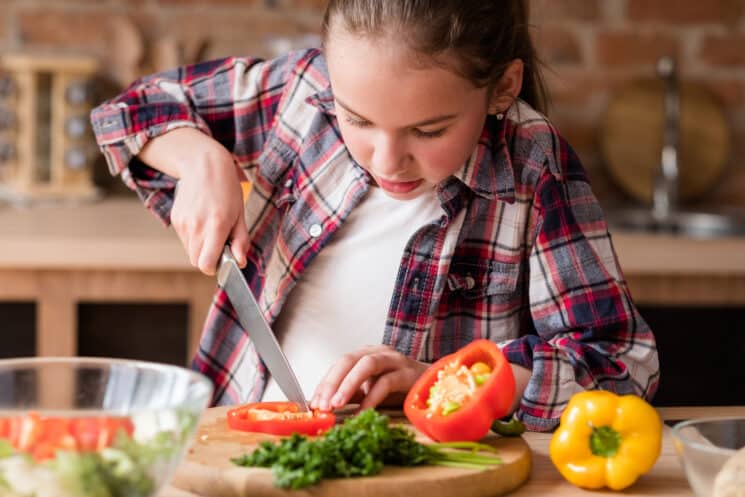
Beyond helping with pouring and mixing, you may be wondering if and when your child can handle a knife safely.
Montessori programs start teaching children to use a knife to cut food starting at 18 months as part of a practical life lesson! Of course, your child needs to be ready, and so do you.
Signs Your Child is Ready to Start Using Knives
Exact age is less important than physical and emotional readiness when it comes to handling knives in the kitchen. Look for these signs that your child may be ready to start:
- He understands that knives need to be handed with care to be safe.
- Her motor skills are strengthening and she can use handheld tools like forks, spoons, and scissors.
- He is able to listen, remember, and follow simple instructions.
- She wants to learn to use a knife (is interested and cautious but not fearful.)
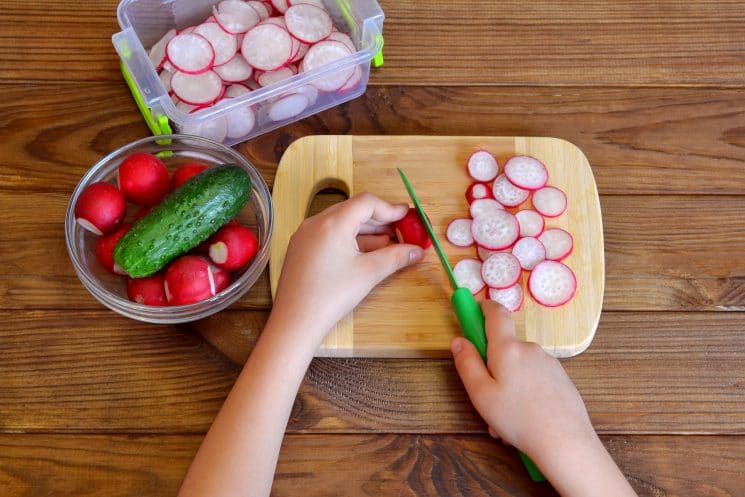
Basic Knife Safety Rules to Teach Your Kids
- Clean first, and clear a space to cut food. Start with washing hands and the food to be cut, as well as a clean knife, cutting board, and a work space cleared of clutter.
- Wear closed-toe shoes. Knives fall sometimes. Your child’s feet are much better protected from an accident with closed toe shoes on.
- Use two hands to cut. One hand should hold the knife, and the other should hold the food in a claw position to keep fingers safe. The hand holding the food should have the fingers tucked under in a “C” shape. Hold the food to be cut on the opposite end of where you are cutting (though very experienced cooks use the knuckles of the hand that is holding the food as a guide for the knife).
- Do not take the knives out of the knife block. Let this be an adult job until you feel like your child can handle removing the knife, the weight of the knife, and carrying a knife.
- Use a cutting board. Make sure the cutting board is large enough to accommodate the food being cut and gives your child plenty of board to maneuver on. Periodically remove the food from the board if there are several items to chop to maintain working room for your child.
- No hands on the cutting board. A hand should never be on the cutting board while a knife is being used. Make sure the knife is safely placed off of the cutting board before you or your child removes the food from the board.
- Keep the tip of the knife on the cutting board. The tip of the knife should remain on the cutting board while cutting. Cutting is done by carefully lifting and lowering the handle.
- Carry a knife safely, and only when an adult says you’re ready. At first, your child won’t be carrying a knife. But make sure you teach him how to properly carry a knife when you feel he is ready. (This is also important if your child empties the dishwasher.) Grasp the handle with the point down and the blade facing backwards. Keep your arm rigid and hold the knife close to the thigh.
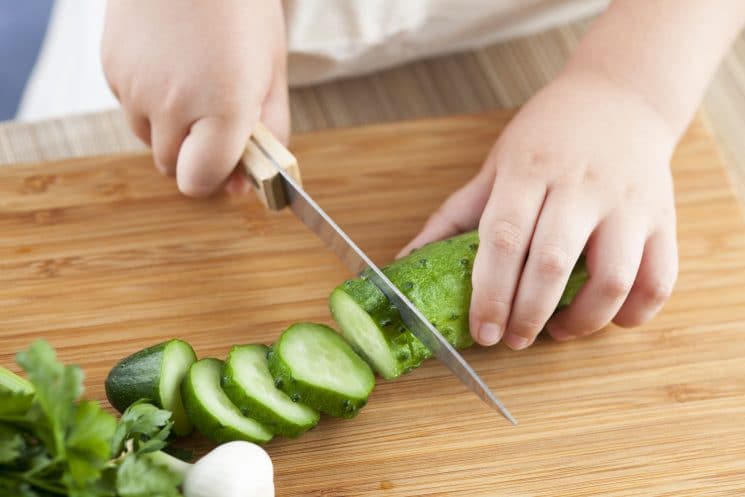
This photo does not show the correct ‘C’ shape kids should be using. Having the fingers tucked in helps prevent them from getting cut.
How You Can Help Your Child Stay Safe and Learn
- Use sharp knives. When the time comes to graduate to a paring knife then a chef’s knife, make sure that you are providing a sharp knife. A sharp knife cuts through food easily. A dull knife will not cut through food easily and requires much more effort to use, causing frustration and potentially slips.
- Start with soft foods. Slicing a peeled, medium-firm banana is a great first task, because your child can cut with gentle pressure. Other good starter foods are pears, strawberries, and mushrooms.
- Resist the temptation to fix non-uniform sizes if possible. When starting, doing what you can to make sure that the knife skills lesson is enjoyable and successful is key. Allowing your child to cut her own banana for snack allows her to be independent, participate in making her snack, and there is no problem with varying sizes.
- Cook with kids. Choose a time to cook alongside your kids when you’re not rushed. I recently had so much fun in the kitchen with my 9 and 7 year olds. I had never asked them to help with asparagus, so getting to wash, break, then cut it was an adventure to them. Since my 9 year old has never been very interested in working in the kitchen, we haven’t worked on her knife skills much. So I sat with her and her brother while they chopped. Demonstrating and making sure that it was done safely. It added time to the process, but we accommodated this by making sure we had plenty of time and by starting early so that dinner could still be ready on time.
- Make a flat edge on foods that are naturally rounded. This is something that you can do for your child at first then gradually allow them to do as knife skills progress. When working with a peeled zucchini, for instance, slice it in half length-wise first so that you can put the zucchini on the flat, cut side for further cutting.
- Make something your child enjoys. Start out by having your child help with a recipe he enjoys so that he can be excited about helping and eating the finished product. My kids LOVE to have frittata for dinner, so when I wanted to get my daughter interested in learning knife skills, I asked her to help me to make an asparagus and tomato frittata for dinner. She was so excited to get the asparagus ready for it (and she got to crack the eggs too). She may have been less excited if we were just chopping asparagus to, for instance, steam.
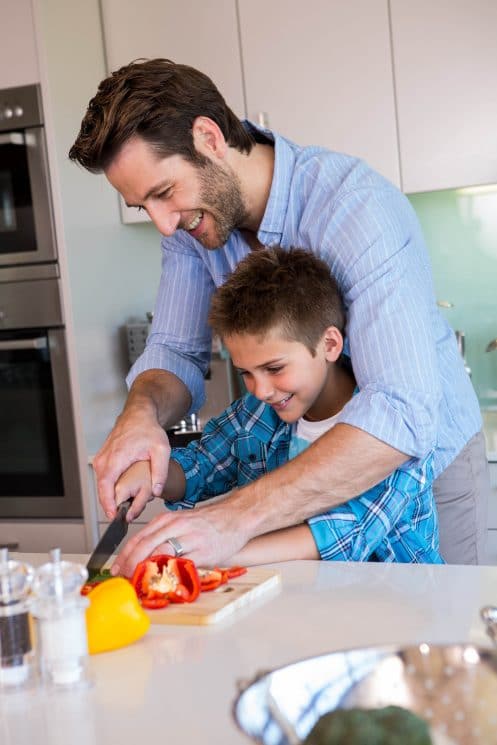
Progressing Knife Skills for Kids
When deciding what your child should and should not cut, consider the guidelines listed below. These apply for the progression of knife skills for any child, so a 4 year old and a 9 year old can start the same way (though possibly progress through stages at different rates).
- Size of food to cut. Start with medium sized foods, then move to smaller foods, then move to large. A medium sized food, like a banana, is easier for a child to start with than a strawberry. And larger food, like a large eggplant, can be hard for your child to maneuver.
- Texture. Start with softer items then progress to more firm.
- Shape. Start with mostly straight items, then as skills progress you can move to round.
- Match food to knife. The food should fit the knife to be used. There is no reason to provide a chef’s knife to cut grapes in half, for instance.
Knife Teaching Guidelines By Age
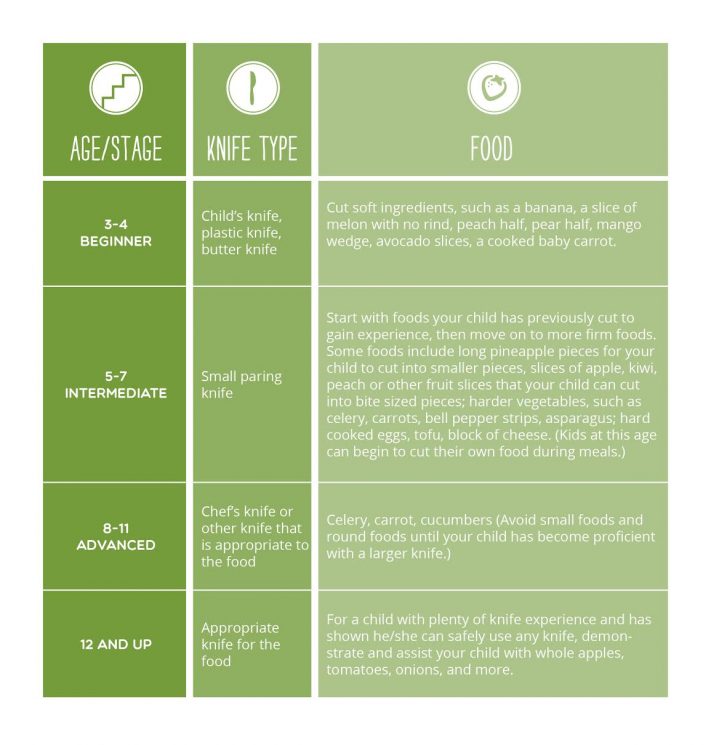
Have them join!
When you are in the kitchen making your family’s meals, wouldn’t it be amazing to have your kids join you? I used to put on a television show while I cooked so that the kids would be entertained. But that was valuable time that we could have spent together building skills, memories, and meals. Invite your kids into your kitchen space to allow you to spend time together. All the while sharing important practical skills, such as learning to use a knife.*These are general guidelines. Consider your child’s skills before progressing. Make sure to remain present to demonstrate skills and ensure proper use of the knife and safety. Prior to moving on to a chef’s knife, make sure that your child has demonstrated knife safety and can handle the weight of the knife.
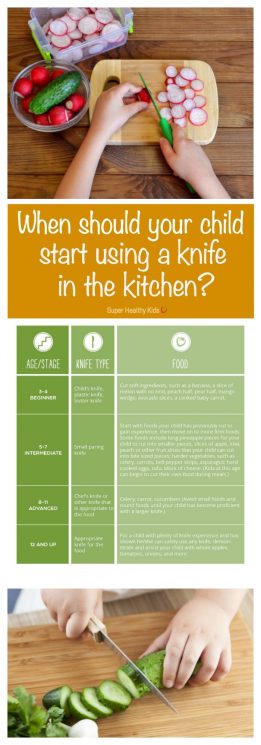
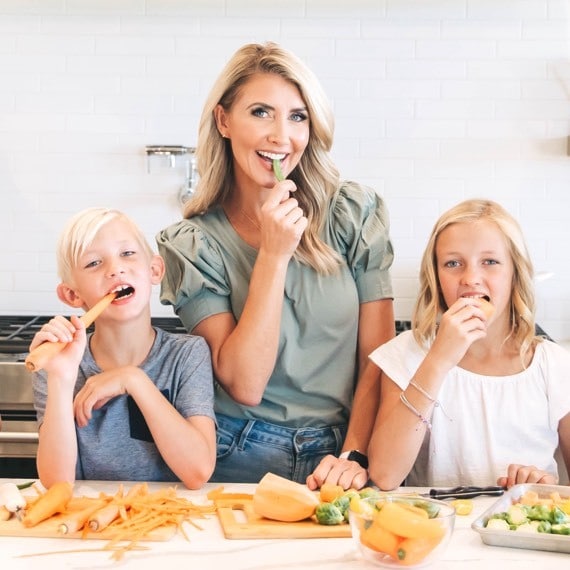
Natalie Monson
I'm a registered dietitian, mom of 4, avid lover of food and strong promoter of healthy habits. Here you will find lots of delicious recipes full of fruits and veggies, tips for getting your kids to eat better and become intuitive eaters and lots of resources for feeding your family.
Learn More about Natalie
I agree that you should have your kids in the kitchen as soon as possible. It’s an important life skill, and I also find it a great way to reinforce basic math skills. My kids started using my chef knives and were very intimidated. I’ve found nylon knives to be a great tool to start them with. The Curious Chef products are great. I also like the Opinel Le Petit Knife for a into stainless steel knife for kids. Thanks for all the tips. I will be using them very soon in my kitchen.
Comments are closed.